

Achaemenid Empire. The Achaemenid Empire (/əˈkiːmənɪd/; Old Persian: Pārsa;[9][10] New Persian: شاهنشاهی هخامنشی c. 550–330 BC), or First Persian Empire,[11] was an empire in Western and Central Asia, founded in the 6th century BC by Cyrus the Great.[11] The dynasty draws its name from king Achaemenes, who ruled Persis between 705 BC and 675 BC.
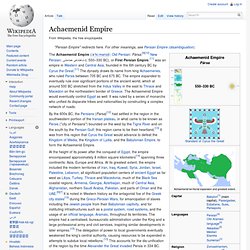
The empire expanded to eventually rule over significant portions of the ancient world, which at around 500 BC stretched from the Indus Valley in the east to Thrace and Macedon on the northeastern border of Greece. The Achaemenid Empire would eventually control Egypt as well. It was ruled by a series of monarchs who unified its disparate tribes and nationalities by constructing a complex network of roads. The historical mark of the Achaemenid Empire went far beyond its territorial and military influences and included cultural, social, technological and religious influences as well. History[edit] Achaemenid Timeline[edit] Astronomical year numbering. Babylonia. Babylonia was an ancient Akkadian-speaking Semitic nation state and cultural region based in central-southern Mesopotamia (present-day Iraq).

It emerged as an independent state c. 1894 BC, with the city of Babylon as its capital. It was often involved in rivalry with its fellow Akkadian state of Assyria in northern Mesopotamia. Babylonia became the major power in the region after Hammurabi (fl. c. 1792 - 1752 BC middle chronology, or c. 1696 – 1654 BC, short chronology) created an empire out of many of the territories of the former Akkadian Empire. The Babylonian state retained the written Semitic Akkadian language for official use (the language of its native populace), despite its Amorite founders and Kassite successors not being native Akkadians. It retained the Sumerian language for religious use, but by the time Babylon was founded this was no longer a spoken language, having been wholly subsumed by Akkadian. Periods[edit] Old Pre-Babylonian period[edit] Kassite. Kassite is a rare mineral whose chemical formula is CaTi2O4(OH)2.
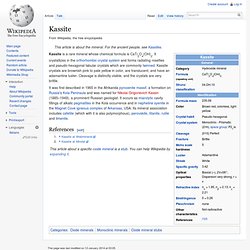
It crystallizes in the orthorhombic crystal system and forms radiating rosettes and pseudo-hexagonal tabular crystals which are commonly twinned. Kassite crystals are brownish pink to pale yellow in color, are translucent, and have an adamantine luster. Cleavage is distinctly visible, and the crystals are very brittle.
It was first described in 1965 in the Afrikanda pyroxenite massif, a formation on Russia's Kola Peninsula and was named for Nikolai Grigorievich Kassin (1885–1949), a prominent Russian geologist. It occurs as miarolytic cavity fillings of alkalic pegmatites in the Kola occurrence and in nepheline syenite in the Magnet Cove igneous complex of Arkansas, USA. Neo-Assyrian Empire. The Neo-Assyrian Empire was an empire in Mesopotamian history which began in 934 BC and ended in 609 BC.[1] During this period, Assyria assumed a position as the most powerful state on earth, successfully eclipsing Babylonia, Egypt, Urartu/Armenia[2] and Elam for dominance of the Near East, Asia Minor, Caucasus, North Africa and east Mediterranean, though not until the reforms of Tiglath-Pileser III in the 8th century BC[3][4] did it become a vast empire.
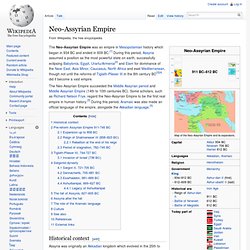
The Neo-Assyrian Empire succeeded the Middle Assyrian period and Middle Assyrian Empire (14th to 10th centuries BC). Some scholars, such as Richard Nelson Frye, regard the Neo-Assyrian Empire to be the first real empire in human history.[5] During this period, Aramaic was also made an official language of the empire, alongside the Akkadian language.[5] Historical context[edit] Assyria was originally an Akkadian kingdom which evolved in the 25th to 24th centuries BC. Neo-Babylonian Empire. The Neo-Babylonian Empire was a period of Mesopotamian history which began in 626 BC and ended in 539 BC.[1] During the preceding three centuries, Babylonia had been ruled by their fellow Akkadian speakers and northern neighbours, Assyria.
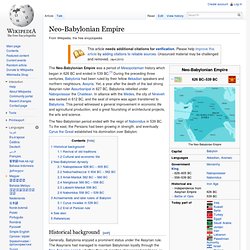
Seleucid Empire. The Seleucid Empire (/sɨˈluːsɪd/; from Greek: Σελεύκεια, Seleúkeia) was a Hellenistic state ruled by the Seleucid dynasty founded by Seleucus I Nicator following the division of the empire created by Alexander the Great.[4][5][6][7] Seleucus received Babylonia and, from there, expanded his dominions to include much of Alexander's near eastern territories.
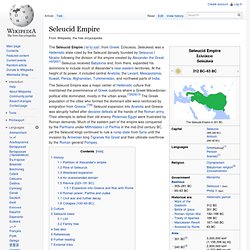
At the height of its power, it included central Anatolia, the Levant, Mesopotamia, Kuwait, Persia, Afghanistan, Turkmenistan, and northwest parts of India. History[edit] Partition of Alexander's empire[edit] Alexander conquered the Persian Empire under its last Achaemenid dynast, Darius III, within a short time frame and died young, leaving an expansive empire of partly Hellenised culture without an adult heir.